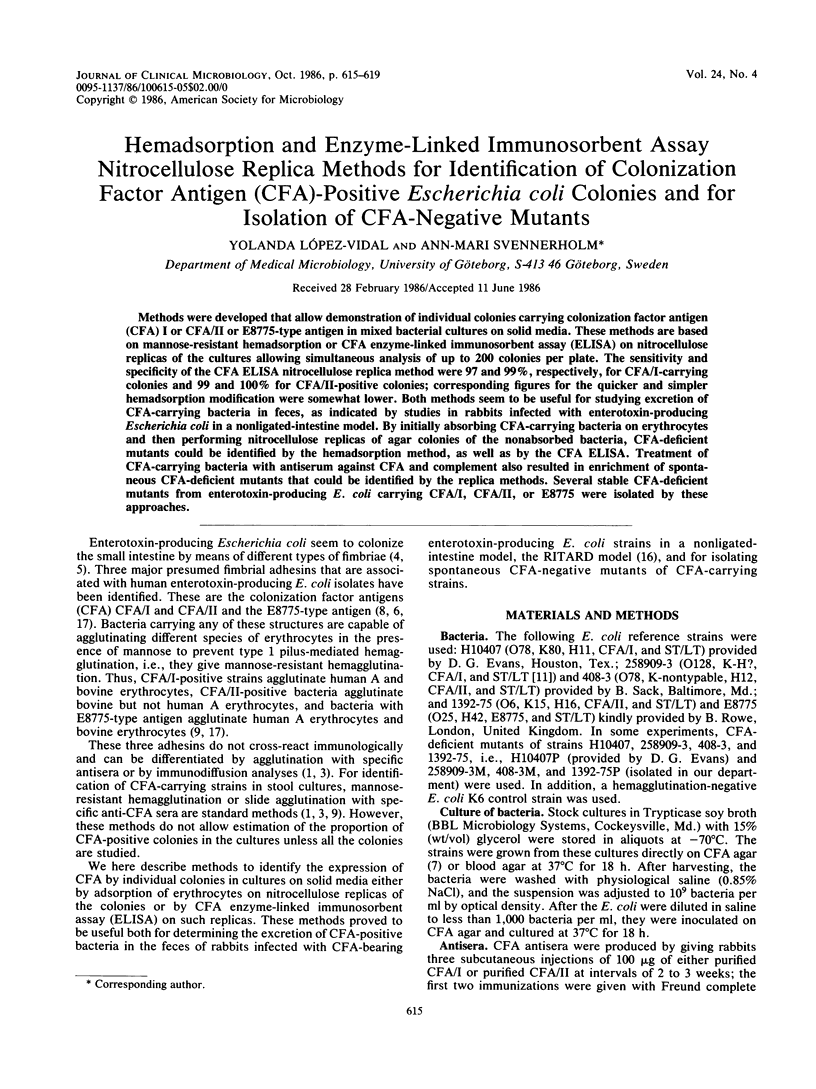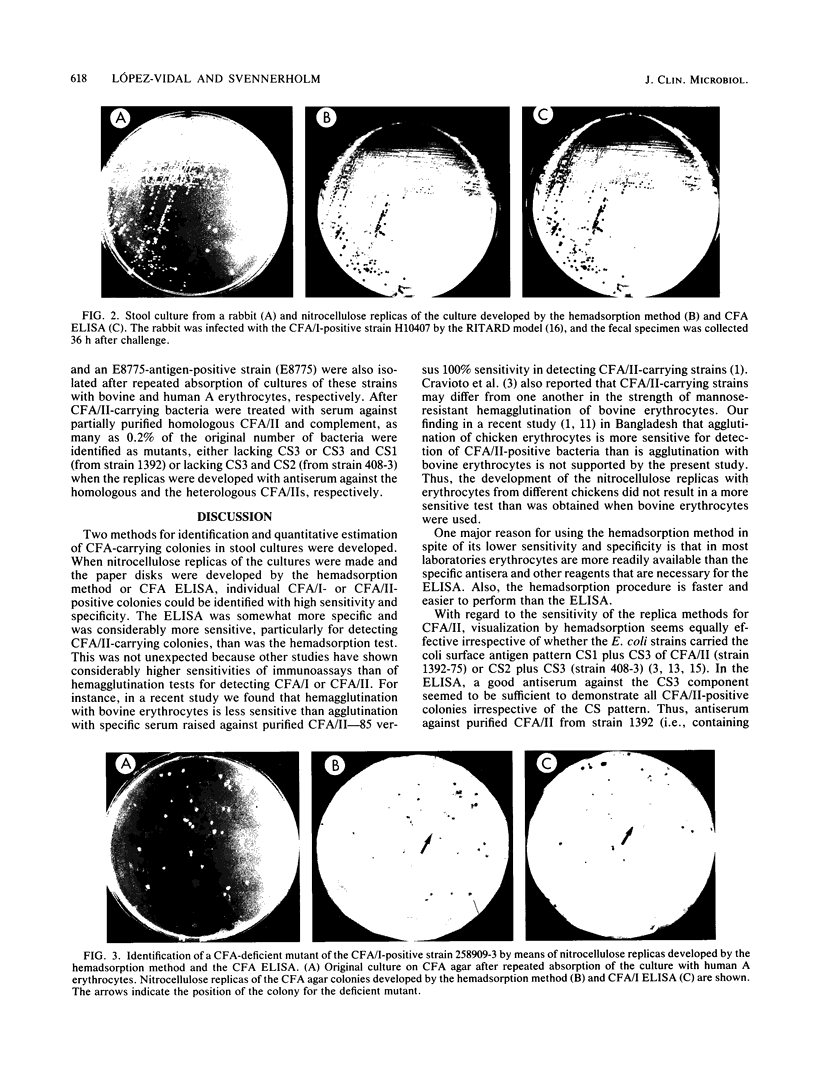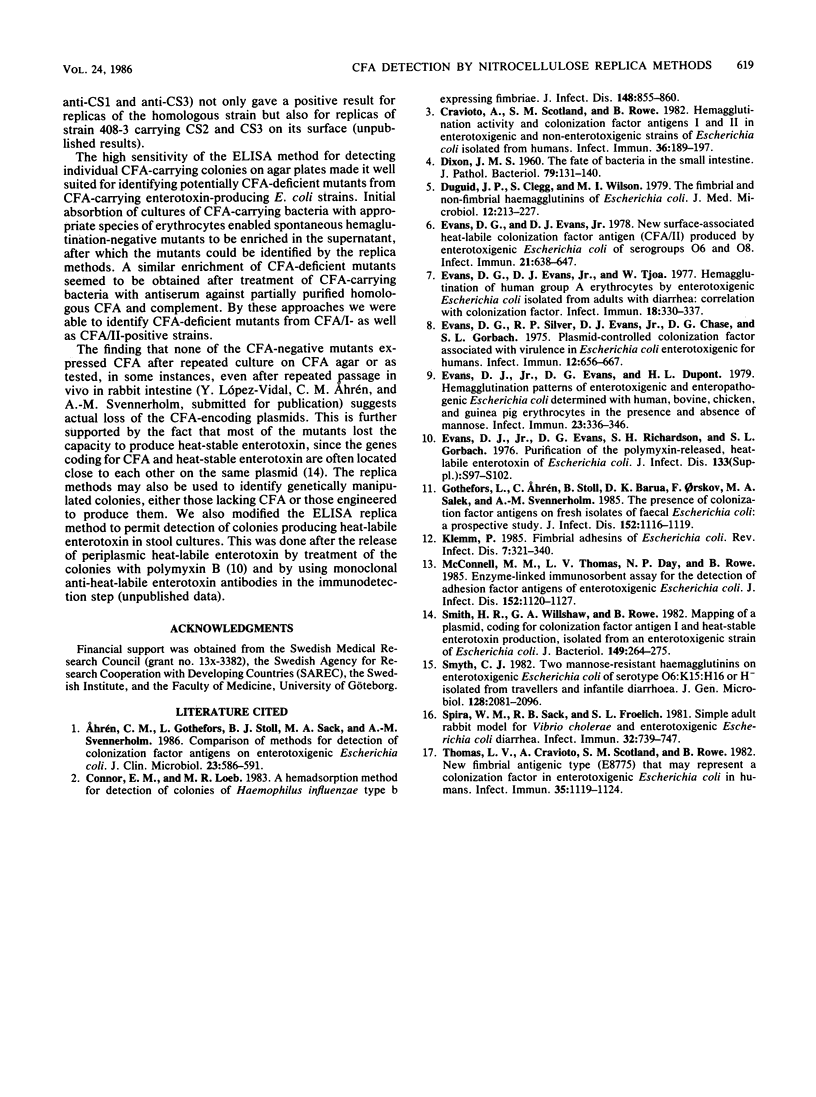Abstract
Methods were developed that allow demonstration of individual colonies carrying colonization factor antigen (CFA) I or CFA/II or E8775-type antigen in mixed bacterial cultures on solid media. These methods are based on mannose-resistant hemadsorption or CFA enzyme-linked immunosorbent assay (ELISA) on nitrocellulose replicas of the cultures allowing simultaneous analysis of up to 200 colonies per plate. The sensitivity and specificity of the CFA ELISA nitrocellulose replica method were 97 and 99%, respectively, for CFA/I-carrying colonies and 99 and 100% for CFA/II-positive colonies; corresponding figures for the quicker and simpler hemadsorption modification were somewhat lower. Both methods seem to be useful for studying excretion of CFA-carrying bacteria in feces, as indicated by studies in rabbits infected with enterotoxin-producing Escherichia coli in a nonligated-intestine model. By initially absorbing CFA-carrying bacteria on erythrocytes and then performing nitrocellulose replicas of agar colonies of the nonabsorbed bacteria, CFA-deficient mutants could be identified by the hemadsorption method, as well as by the CFA ELISA. Treatment of CFA-carrying bacteria with antiserum against CFA and complement also resulted in enrichment of spontaneous CFA-deficient mutants that could be identified by the replica methods. Several stable CFA-deficient mutants from enterotoxin-producing E. coli carrying CFA/I, CFA/II, or E8775 were isolated by these approaches.
Full text
PDF




Images in this article
Selected References
These references are in PubMed. This may not be the complete list of references from this article.
- Ahrén C. M., Gothefors L., Stoll B. J., Salek M. A., Svennerholm A. M. Comparison of methods for detection of colonization factor antigens on enterotoxigenic Escherichia coli. J Clin Microbiol. 1986 Mar;23(3):586–591. doi: 10.1128/jcm.23.3.586-591.1986. [DOI] [PMC free article] [PubMed] [Google Scholar]
- Connor E. M., Loeb M. R. A hemadsorption method for detection of colonies of Haemophilus influenzae type b expressing fimbriae. J Infect Dis. 1983 Nov;148(5):855–860. doi: 10.1093/infdis/148.5.855. [DOI] [PubMed] [Google Scholar]
- Cravioto A., Scotland S. M., Rowe B. Hemagglutination activity and colonization factor antigens I and II in enterotoxigenic and non-enterotoxigenic strains of Escherichia coli isolated from humans. Infect Immun. 1982 Apr;36(1):189–197. doi: 10.1128/iai.36.1.189-197.1982. [DOI] [PMC free article] [PubMed] [Google Scholar]
- DIXON J. M. The fate of bacteria in the small intestine. J Pathol Bacteriol. 1960 Jan;79:131–140. doi: 10.1002/path.1700790116. [DOI] [PubMed] [Google Scholar]
- Duguid J. P., Clegg S., Wilson M. I. The fimbrial and non-fimbrial haemagglutinins of Escherichia coli. J Med Microbiol. 1979 May;12(2):213–227. doi: 10.1099/00222615-12-2-213. [DOI] [PubMed] [Google Scholar]
- Evans D. G., Evans D. J., Jr New surface-associated heat-labile colonization factor antigen (CFA/II) produced by enterotoxigenic Escherichia coli of serogroups O6 and O8. Infect Immun. 1978 Aug;21(2):638–647. doi: 10.1128/iai.21.2.638-647.1978. [DOI] [PMC free article] [PubMed] [Google Scholar]
- Evans D. G., Evans D. J., Jr, Tjoa W. Hemagglutination of human group A erythrocytes by enterotoxigenic Escherichia coli isolated from adults with diarrhea: correlation with colonization factor. Infect Immun. 1977 Nov;18(2):330–337. doi: 10.1128/iai.18.2.330-337.1977. [DOI] [PMC free article] [PubMed] [Google Scholar]
- Evans D. G., Silver R. P., Evans D. J., Jr, Chase D. G., Gorbach S. L. Plasmid-controlled colonization factor associated with virulence in Esherichia coli enterotoxigenic for humans. Infect Immun. 1975 Sep;12(3):656–667. doi: 10.1128/iai.12.3.656-667.1975. [DOI] [PMC free article] [PubMed] [Google Scholar]
- Evans D. J., Jr, Evans D. G., DuPont H. L. Hemagglutination patterns of enterotoxigenic and enteropathogenic Escherichia coli determined with human, bovine, chicken, and guinea pig erythrocytes in the presence and absence of mannose. Infect Immun. 1979 Feb;23(2):336–346. doi: 10.1128/iai.23.2.336-346.1979. [DOI] [PMC free article] [PubMed] [Google Scholar]
- Klemm P. Fimbrial adhesions of Escherichia coli. Rev Infect Dis. 1985 May-Jun;7(3):321–340. doi: 10.1093/clinids/7.3.321. [DOI] [PubMed] [Google Scholar]
- McConnell M. M., Thomas L. V., Day N. P., Rowe B. Enzyme-linked immunosorbent assays for the detection of adhesion factor antigens of enterotoxigenic Escherichia coli. J Infect Dis. 1985 Dec;152(6):1120–1127. doi: 10.1093/infdis/152.6.1120. [DOI] [PubMed] [Google Scholar]
- Smith H. R., Willshaw G. A., Rowe B. Mapping of a plasmid, coding for colonization, factor antigen I and heat-stable enterotoxin production, isolated from an enterotoxigenic strain of Escherichia coli. J Bacteriol. 1982 Jan;149(1):264–275. doi: 10.1128/jb.149.1.264-275.1982. [DOI] [PMC free article] [PubMed] [Google Scholar]
- Smyth C. J. Two mannose-resistant haemagglutinins on enterotoxigenic Escherichia coli of serotype O6:K15:H16 or H-isolated from travellers' and infantile diarrhoea. J Gen Microbiol. 1982 Sep;128(9):2081–2096. doi: 10.1099/00221287-128-9-2081. [DOI] [PubMed] [Google Scholar]
- Spira W. M., Sack R. B., Froehlich J. L. Simple adult rabbit model for Vibrio cholerae and enterotoxigenic Escherichia coli diarrhea. Infect Immun. 1981 May;32(2):739–747. doi: 10.1128/iai.32.2.739-747.1981. [DOI] [PMC free article] [PubMed] [Google Scholar]
- Thomas L. V., Cravioto A., Scotland S. M., Rowe B. New fimbrial antigenic type (E8775) that may represent a colonization factor in enterotoxigenic Escherichia coli in humans. Infect Immun. 1982 Mar;35(3):1119–1124. doi: 10.1128/iai.35.3.1119-1124.1982. [DOI] [PMC free article] [PubMed] [Google Scholar]




